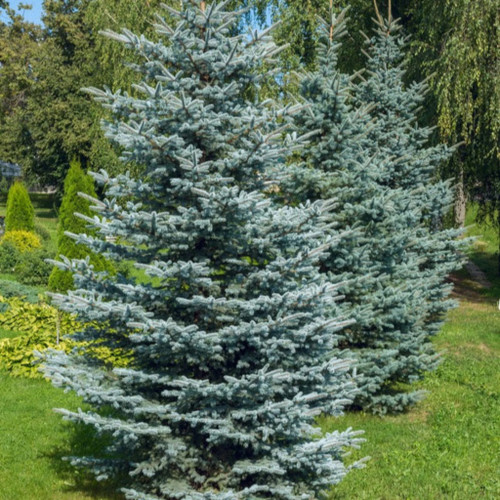
Spruce Trees
Uses:
- Specimen or Focal Point
- Windbreak
- Privacy Screen
Features:
- Evergreen
- Foliage Interest
- Pleasant Fragrance
- Wildlife Habitat
Sunlight:
- Full Sun
- 6+ Hours of Direct Sun
Growing Zones:
- 3-8
- What is My Zone?
Spruce trees are evergreen conifers in the genus Picea. The needles are found individually on branches and have four sides, distinguishing them from pines and firs. The needles are typically blue to green in color and have a pleasant, woody fragrance. Spruce cones are produced in a two-year cycle and have a papery, flexible feel. These trees often have a conical shape and make lovely Christmas trees.
About Spruce Trees

Baltic Whitewood, European Spruce, Norway Spruce
Europe, USA
Trees
Evergreen
2 - 7
Seed Cones
Spring
Conical, Dense, Pyramidal
Small Mammals, Songbirds
Pollution
Deer
How To Use Spruce Trees In The Garden
Spruce trees, belonging to the genus Picea, are large coniferous evergreens native to temperate regions of the Northern Hemisphere. They are characterized by their four-sided needles and downward-hanging cones upon maturity. Various species come in intriguing hues, from subtly bluish tips to occasional golden undertones, providing evergreen interest in all seasons. They are well adapted to cold climates, tolerating harsh winters and offering a dependable canopy for shade or wind protection. These trees are valuable for providing noise and wind barriers and serve as essential habitats for wildlife.
Spruce trees are often utilized as living privacy screens or specimen plants due to their dense foliage and symmetrical form. Certain dwarf varieties are suitable for large containers, adding a striking year-round silhouette to patio spaces or entryways. Larger landscapes often benefit from combining different spruces—whether standard, weeping, or color-contrasting—to create dimension and texture. Paired with flowering shrubs and perennials, they bring a steady anchor through winter’s chill and unify the design the rest of the year.
Types of Spruce Trees
| Type | Scientific Name | Native Range | Foliage | Zones | Uses | Features |
|---|---|---|---|---|---|---|
| White Spruce | Picea glauca | Boreal Canada & AK south to MN, WI, MI, NY | Blue-green needles, aromatic, glaucous bloom | 2 – 6 | Windbreaks, screens, specimens, wildlife cover | Extremely hardy; tolerates deer, clay & alkaline soil; smallest spruce cones (1–2 in.); dislikes heat/humidity |
| Colorado (Blue) Spruce | Picea pungens | Central Rocky Mts. (MT/ID to NM) | Stiff 4-sided needles; green to silver-blue | 2 – 7 | Specimens, accents, Christmas trees, drought-tolerant screens | Silvery-blue foliage valued; drought, rabbit, deer & pollution tolerant; large flexible cones; sensitive to heat & spider mites |
| Norway Spruce | Picea abies | Mountains of N. & C. Europe east to Urals | Dark green, needles, blunt tips | 2 – 7 | Windbreaks, large lawns/parks, screens; many dwarf cultivars | Longest spruce cones (4–6 in.); pendulous branchlets with age; tolerates deer & air pollution; best in cool summers |
Spruce Tree Care
Spruce trees grow best in well-draining, fertile loamy soil and need 6-8 hours of direct sunlight daily. Plant by digging a hole twice the root ball's width, backfill with soil, and water deeply. Keep the soil moist during the first growing season, adding mulch around the base for moisture retention. Fertilize sparingly, only if growth is weak or needles appear discolored.
Prune to remove dead or damaged branches, using sterilized tools for clean cuts. Dwarf varieties grow well in large containers with good drainage, placed in sunny areas. Water container-grown trees when the topsoil feels dry. For winter care, apply mulch to insulate roots and wrap young trees in burlap in exposed areas to protect from windburn.
Learn More About Spruce Tree Care

Spruce Tree Companion Plants
Give spruce a site with full sun and slightly acidic, yet fast‑draining soil that stays evenly moist. Add companions that tolerate the tree’s shallow roots and dappled shade beneath the canopy. Hydrangea and evergreen rhododendron supply long‑season flowers and bold foliage that read clearly against the conifer’s needles. Hostas settle into the dry, shady root zone to carpet the ground with broad leaves and contrasting texture. A drift of shasta daisies provides summer color and a contrasting daisy form without resenting the leaner soil.

















